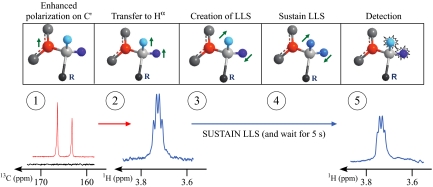Fig. 1.
The DNP-LLS experiment. (i) Signal of hyperpolarized carbonyl 13C spins (highlighted in red) of Ala-Gly detected using a single 10° pulse (red trace) compared with a room-temperature spectrum (black trace) obtained by averaging 128 scans using 90° pulses. (ii) Proton signals of the two Gly-Hα spins in Ala-Gly (in light and dark blue). (iii) Conversion into an LLS involving two inequivalent spins. (iv) These proton spins (in blue) are temporarily rendered equivalent by WALTZ irradiation (see Methods) to sustain the LLS. (v) The same proton signals, following an interval τm = 5 s where LLS are sustained.

